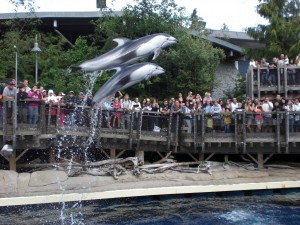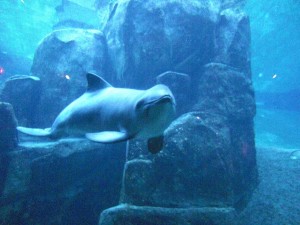7. Regulations
Regulations
As with many animal welfare topics, there are different levels of rules and regulations involved.
The Vancouver Aquarium is the only facility in BC that keeps cetaceans for public display. Because the Aquarium is located in Stanley Park it is subject to the rules of the Vancouver Parks Board. The Vancouver Board of Parks and Recreation has a by-law regarding the keeping of cetaceans in city parks. This by-law states that no person shall bring into, keep or maintain any aquatic animal of the Cetacean order which has been captured or otherwise taken from its natural habitat. The exceptions to this by-law are animals that were born into captivity, captured before September 16, 1996, or are injured and need of assistance to survive or rehabilitate (Vancouver Board of Parks and Recreation, 2008). Endangered Cetacean species are also allowed, provided the Parks Board has given approval. This means that the Vancouver Aquarium is not permitted to bring in any wild caught cetaceans unless they have been kept in captivity since 1996 or are rescued animals that are non-releaseable.
Hana and Helen,the two Pacific White Sided dolphins residing at the aquarium came from Japan, where they had been rescued after being caught in fishing nets, and had been deemed non-releasable by the Japanese government.
Daisy, the harbor porpoise residing at the aquarium, was rescued by the Aquarium’s Marine Mammal Rescue (MMR) facility, at approximately 1 month of age, and hand-raised by staff at the MMR.
Canadian Laws
The Department of Fisheries and Oceans (DFO) has the regulatory control over the capture of marine mammals in Canada. The laws regarding capture of cetaceans indicate that hunting of these animals is permitted but only by persons who have been granted a license, or by Indian or Inuk people that are fishing for “food, social or ceremonial purposes” (Marine Mammal Regulations 1993). Capture and transport for public display purposes requires a license issued under the Fishery (General) Regulations (1993). There are no regulations in place under these acts for the care of captive marine mammals, because once the animal has been removed from the wild it is considered private property (Lien 1999). The DFO also controls the determination of “non-releasable” status to rescued marine mammals (Lien 1999). The two harbor porpoises at the Vancouver Aquarium were deemed non-releasable by DFO officials after their rescue and rehabilitation by the Aquarium’s Marine Mammal Rescue Centre (Vancouver Aquarium 2012). Animal welfare in Canada is regulated by Section 446 of the Criminal Code, which forbids unnecessary suffering for animals and provides penalties for abuses, but does not provide routine inspections or enforcement of maintenance standards (Lien 1999).
U.S. Laws
The United States has much more stringent laws regarding the capture and maintenance of marine mammals. The 1972 Marine Mammal Protection Act prohibits the import or taking of marine mammals except where permits had been given for scientific or public display purposes (Lien 1999). In order to be granted a public display permit in the US, a facility has to “offer a program for education or conservation purposes that is based on professionally recognized standards of the public display community” (Marine Mamma Protection Act 2007). Only facilities that are open to the public and provide education or conservation programs are permitted to hold cetaceans for public display.
Care Guidelines for Captive Cetaceans in Canada
Aquariums and zoos in Canada have to follow animal care standards and guidelines outlined by the Canadian Association of Zoos and Aquariums (CAZA) in order to be classified as CAZA accredited facilities. This program is voluntary and involves an inspection every 5 years to ensure the facility is maintaining it’s animals according to the standards set out in the CAZA Animal Care and Housing Manual. This is a general set of standards that is applied to any captive species, which includes standards such as adequate space for exercising natural behaviours “to facilitate public education and interpretation” and prevent stress (CAZA 2008). The guidelines are intended to make sure that captive animals are housed and cared for in the best manner possible in a zoo or aquarium setting. It involves standards regarding housing, animal care, facility cleanliness, staff, public safety, and more (CAZA 2008). This set of guidelines is a great starting point for the care and maintenance of zoo and aquarium animals, but it is vague on specifics for different species. The guidelines document provides a list of references at the end that go into further detail on care of specific animals, and zoological, veterinary, and animal care experts are involved in the inspection and accreditation processes. CAZA accreditation provides a number of benefits to a facility, from better public perception to access to grants to exchange of animals for breeding purposes (CAZA website 2012). CAZA is a non-profit organization that has the goals of conservation and improving the care and management of captive animals in Canada.
Care for Captive Cetaceans in the USA
The Association of Zoos and Aquariums (AZA) fulfills the same role in the US that CAZA does in Canada. In fact, the standards and procedures that CAZA uses were developed based off of standards maintained by the AZA (CAZA website, 2012). The AZA has an extensive accreditation process, involving thorough inspections like CAZA does. Instead of one general Animal Care Guidelines like CAZA has, the AZA has a selection of specific care guides for different species. Not all of these care guides are completed, and the Dolphin Care guide is still being reviewed by external experts as well as AZA members (AZA website 2012). AZA standards involve a high level of animal care, housing, management and welfare. AZA membership is voluntary, much like CAZA membership, and provides the same kinds of benefits. The Vancouver Aquarium is a member of both CAZA and AZA.

